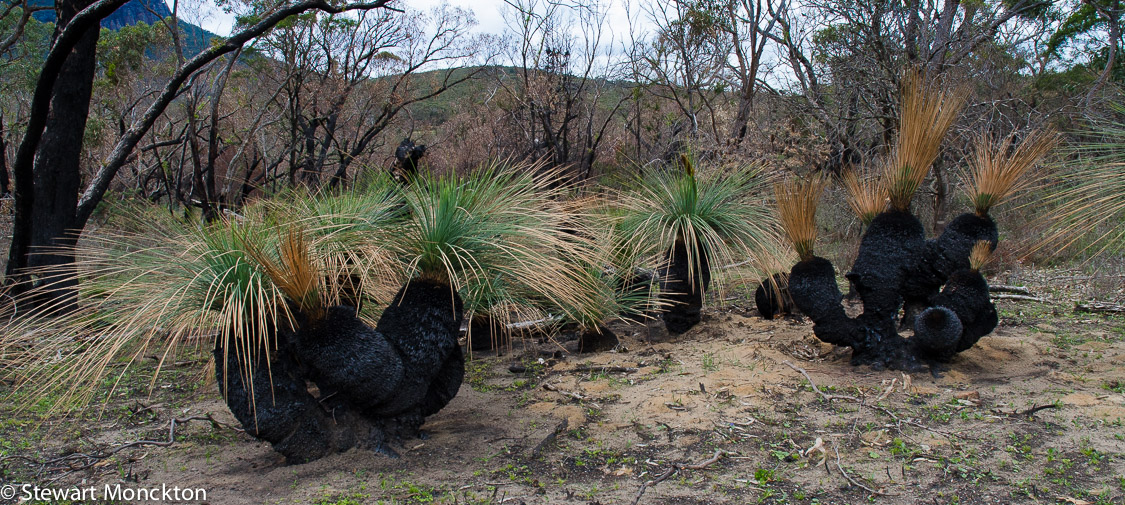The blackened stem is not a true stem at all really, but a hollow structure formed the the base of the of the leaves. Roots run down through the hollow centre to connect to the ground.
These plants often respond to fire by sending up large flower stalks, and after a fire they can become very visible in the bush. Far from destroying the plant, fire is vital to its long tern survival.
This kind of relationship with fire is common in Australia.
The larger plants in these pictures are likely to be well over a hundred years old - you may not be surprised to learn that these older plants are sometimes stolen from the bush and sold on the black market! Thankfully, there seems to be some regulation to prevent this.
All of these pictures were taken in the Grampians - a National Park about a 3 1/2 hours from Melbourne.
You can find more pictures from around the world at Our World Tuesday.






How very interesting - and unique! I learn something new everytime I visit your blog! Thanks for sharing this.
ReplyDeleteOh wow, quite an interesting-looking tree indeed Stewart!
ReplyDeleteWhat an interesting plant! I'd love to see those Aussie plants one of thes years.
ReplyDeleteI love these glimpses of your adopted home.
ReplyDeleteCheers
ontzettend mooi maar ook fijn dat je er z,on mooie uitleg bij geeft.
ReplyDeleteWhat an exceptional, very interesting post! I'm glad you shared this with us.
ReplyDeleteThis comment has been removed by the author.
ReplyDeleteVery interesting -- twisted but beautiful shapes... really enjoyed this.
ReplyDelete"We" over here are only recently starting to acknowledge that naturally-caused forest burns are not always bad. The Native Americans knew that, but that knowledge has been ignored for too long. Some areas are so terribly overgrown that when there is a fire it gets quickly out of control.
wow! very unique!
ReplyDeleteHow interesting. Those black trunks and stems are in stark contrast to the new growth.
ReplyDeleteCool! These look very familiar to beargrass, which blooms in early summer in the Cascade mountains.
ReplyDeleteSuch cool looking plants! Excellent shots with great detail Stewart. Lorikeets like to eat the flowers don't they?
ReplyDeleteVery interesting!
ReplyDeleteHave a great day!
Lea
I've never heard of this plant. Very interesting!
ReplyDeleteWonderful shapes and forms.
ReplyDeleteUnique and pretty trees ~ great shots and wonderfully informative post! ~
ReplyDeleteartmusedog and carol (A Creative Harbor) ~ Happy Week to you!
Great post and wonderful captures, Stewart, as always!! Thanks for sharing this with us today!! Have a great week!
ReplyDeleteStewart, they are cool looking trees. Thanks for sharing. Have a happy week!
ReplyDeleteVery neat how fire helps the plants! Great shots of a very interesting subject!
ReplyDeleteWow! Those are interesting looking plants! I love such articles with something I don't see in my part of the world!
ReplyDeleteWhat a most interesting plant. You guys sure have some neat stuff down there. Thanks for sharing that Stewart.
ReplyDeleteGreat shots. Nature always finds a way to bounce back!
ReplyDeleteA beautiful part of our Australian landscape Stewart. As children born and bred in rural South Australia my sisters and I would often cut the smaller flower spikes to use as make-believe kangaroo tails.
ReplyDeleteBeautiful pictures Stewart.
ReplyDeleteRare plants are these, pictures 3 and 4 are my favorite.
Best regards, Irma
I have never seen those trees. How amazingly beautiful ...but what a shame that people just take them.
ReplyDeleteMy first time to see this kind of plant. Awesome shots.
ReplyDeleteThanks for stopping by.
www.1sthappyfamily.com
lol, I was some of them in Queensland, but they were not in bloom then. :) Nice to see them.
ReplyDeletehttp://nftravel.blogspot.se/2014/10/140909-queensland-atherton-tablelands.html
They are fascinating plants! I am glad they are protected!
ReplyDeleteOne of the most unusual and fascinating plants I've ever seen. Thanks for sharing.
ReplyDeleteI love seeing your natural habitat.
ReplyDeleteHow interesting!
ReplyDeleteIt's always wonderful to see the forest and bushland's response to fire.